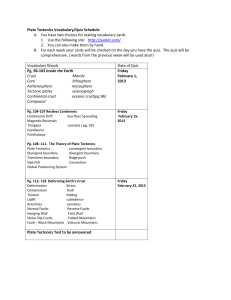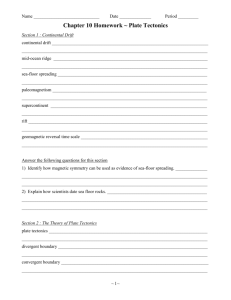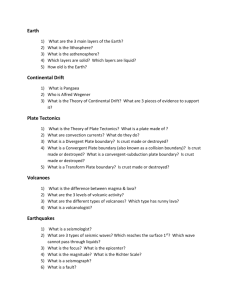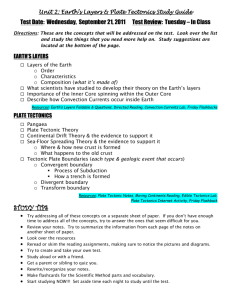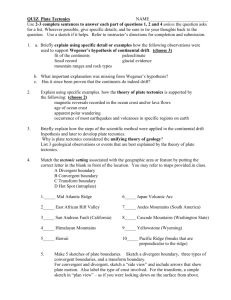Name Semester 2 Final Exam Review Unit 4
advertisement
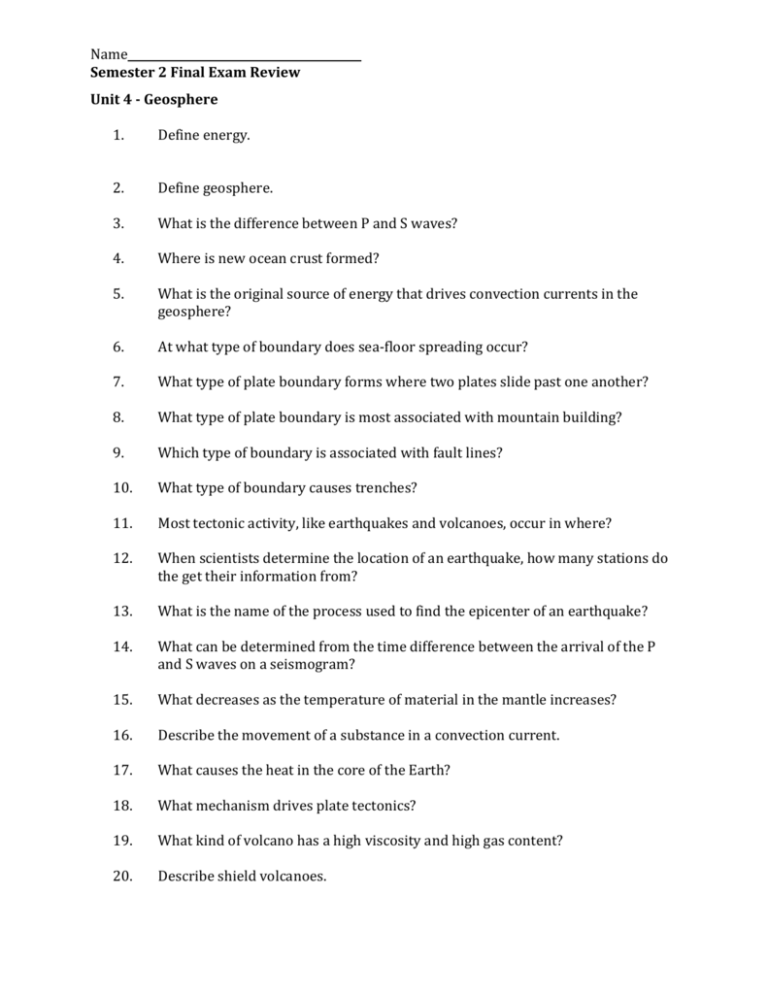
Name Semester 2 Final Exam Review Unit 4 - Geosphere 1. Define energy. 2. Define geosphere. 3. What is the difference between P and S waves? 4. Where is new ocean crust formed? 5. What is the original source of energy that drives convection currents in the geosphere? 6. At what type of boundary does sea-floor spreading occur? 7. What type of plate boundary forms where two plates slide past one another? 8. What type of plate boundary is most associated with mountain building? 9. Which type of boundary is associated with fault lines? 10. What type of boundary causes trenches? 11. Most tectonic activity, like earthquakes and volcanoes, occur in where? 12. When scientists determine the location of an earthquake, how many stations do the get their information from? 13. What is the name of the process used to find the epicenter of an earthquake? 14. What can be determined from the time difference between the arrival of the P and S waves on a seismogram? 15. What decreases as the temperature of material in the mantle increases? 16. Describe the movement of a substance in a convection current. 17. What causes the heat in the core of the Earth? 18. What mechanism drives plate tectonics? 19. What kind of volcano has a high viscosity and high gas content? 20. Describe shield volcanoes. Name Semester 2 Final Exam Review 21. What two factors determine the type of volcano and how explosive it is? 22. Define the theory of plate tectonics. 23. What did Wegener observe that helped him develop his theory of continental drift? 24. What observations did Hess make that contributed to the Theory of Plate Tectonics? 25. What Law is demonstrated when new crust is added at divergent boundaries, and crust is recycled at convergent boundaries? 26. List the layers of Earth in increasing density. 27. List examples of evidence for the Theory of Plate Tectonics. 28. Calculate the density of a 90cm3 rock that has a mass of 800g. (Show your work.) D=m/v 29. If the S-P lag time of a particular earthquake was 62 seconds, use the graph below to determine the distance away from the seismic station. a. 580 km b. 600 km c. 630 km Unit 5 Natural Resources 30. What are natural resources? Define it. 31. Provide 3 examples of natural resources. 32. Define “renewable resource”. Name Semester 2 Final Exam Review 33. Provide 3 examples of renewable resources. 34. Define “non-renewable resource”. 35. Provide 3 examples of non-renewable resources. 36. In the U.S. what fossil fuel do we consume the most in our demand for energy? Is it renewable? 37. What are the human impacts of natural resource usage? Unit 6 – Cyrosphere 38. What happens to salt when ocean water freezes? 39. How would melting of snow and ice affect the albedo of the planet? 40. Define the following components of the cryosphere: a. Ice sheet b. Ice shelf c. Iceberg d. Glacier e. Moraine f. Sea ice – g. Permafrost - 41. Which of the components listed above will increase sea levels when it melts? 42. What is albedo? What factors increase albedo? 43. Why does ice float and what would happen if it didn’t float? 44. What happens when an area’s albedo is decreased? Name Semester 2 Final Exam Review 45. What is a moraine? Unit 7 Hydrosphere 46. How much fresh water is available for human use? What source does this come from? 47. Compare the density of water when it is a solid and a liquid. 48. Define the following characteristics of water and provide an example of each. a. Surface tension b. Polarity c. Adhesion d. Cohesion 49. e. Specific Heat Capacity Draw and label the parts of a water molecule. 50. List and describe the parts of the water cycle. 51. 52. How does water’s specific heat affect the temperature change of water? 53. What is the relationship between temperature and density of water? 54. What property of water is responsible for regulation global climate? 55. What happens to the salinity of water as ice forms? 56. What causes surface currents? 57. What source of energy drives the hydrologic cycle? 58. How much energy is required to change the temperature of a 720g sample of water, from 23oC up to 49oC? (Show all work.) Q = cpmT cp,water = 4.19 J/goC Name Semester 2 Final Exam Review 59. In what ways can an aquifer be recharged? 60. Rate (or speed) is measured as distance/time. If a plume of contamination has been travelling for 25 years and has moved 1100 meters in that time. How fast (or slow) is this plume moving? 61. What type of contaminants can get into groundwater? Unit 8 Biosphere 62. What is the difference between biotic and abiotic factors? Give some examples of each. 63. List the characteristics of living things. 64. What is ecology? 65. Describe autotrophs. 66. What part of the visible spectrum is absorbed most by chlorophyll? 67. What are the reactants of photosynthesis? 68. What is the energy transformation in photosynthesis? 69. What pigment is responsible for absorbing light energy? 70. How much energy is transferred from one trophic level to the next? 71. What is a heterotroph? 72. What type of organism is a mushroom? 73. Why does the amount of biomass decrease as one moves up in the trophic levels? 74. What form of energy is lost with each transformation? 75. What gas is produced as a result of photosynthesis? 76. What are sources of carbon? 77. What process cycles carbon from the atmosphere to the natural world? 78. What organism is necessary for nitrogen fixation? Name Semester 2 Final Exam Review 79. What carbon reservoir releases carbon into the atmosphere through human activities? 80. What can reduce the health of an ecosystem? 81. What is a limiting factor? 82. What is the carrying capacity of a population? 83. Why is competition a limiting factor? 84. Make a simple food chain using some of the organisms in the pyramid and then label them as producers, etc…. Organisms: ___________ ___________ ___________ ___________ ___________ Trophic Level: __________ ___________ ___________ ___________ ___________


